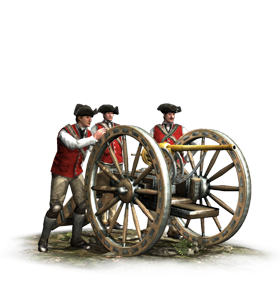Difference between revisions of "Puckle Guns (ETW Unit)"
(→Game Description) |
(→Overview) |
||
| Line 8: | Line 8: | ||
Historically, James Puckle’s “defence gun” was not a huge success, partly because the engineering of 1718 simply wasn't up to the task of producing components with fine tolerances. His gun had promise, though, as it could fire shots around three times faster than a well-trained fusilier. One odd feature of the design was the two versions offered to potential customers: a round barrel fired conventional bullets for shooting at Christian (but not Protestant) enemies, while a second barrel was offered that fired square bullets (that allegedly did more damage) for use against Turks and similar unwelcome infidels. The British Royal Navy never bought any, and other users were equally reluctant to part with their money. Puckle’s career as a gunsmith ended in failure for him and his investors. | Historically, James Puckle’s “defence gun” was not a huge success, partly because the engineering of 1718 simply wasn't up to the task of producing components with fine tolerances. His gun had promise, though, as it could fire shots around three times faster than a well-trained fusilier. One odd feature of the design was the two versions offered to potential customers: a round barrel fired conventional bullets for shooting at Christian (but not Protestant) enemies, while a second barrel was offered that fired square bullets (that allegedly did more damage) for use against Turks and similar unwelcome infidels. The British Royal Navy never bought any, and other users were equally reluctant to part with their money. Puckle’s career as a gunsmith ended in failure for him and his investors. | ||
| − | == | + | ==Details== |
| − | The Puckle Gun is most effective at close range, since at longer ranges many shots do not hit the target. It is useful for repelling cavalry charges and massed infantry attacks, due to its sustained fire. | + | |
| + | The Puckle Gun is most effective at close range, since at longer ranges many shots do not hit the target. It is useful for repelling cavalry charges and massed infantry attacks, due to its sustained fire. Puckle guns reload more quickly than the other artillery types, aiding them in their ability to produce sustained fire. Unfortunately, their range is also far inferior to any other artillery type, restricting them to close combat. | ||
==Factions== | ==Factions== | ||
Revision as of 10:09, 10 October 2011
 The Puckle gun is a tripod-mounted repeating heavy musket or small cannon, capable of rapid fire.
The Puckle gun is a tripod-mounted repeating heavy musket or small cannon, capable of rapid fire.
Overview
It achieves its rapid-fire capability by using pre-loaded breech chambers that are rotated into line with the barrel, fired and then a new chamber is positioned for the next shot. All this is achieved mechanically, by the operator revolving a handle at the back of the piece. As long as loaded magazines are available for the piece, a puckle gun can be kept in rapid fire action!
Historically, James Puckle’s “defence gun” was not a huge success, partly because the engineering of 1718 simply wasn't up to the task of producing components with fine tolerances. His gun had promise, though, as it could fire shots around three times faster than a well-trained fusilier. One odd feature of the design was the two versions offered to potential customers: a round barrel fired conventional bullets for shooting at Christian (but not Protestant) enemies, while a second barrel was offered that fired square bullets (that allegedly did more damage) for use against Turks and similar unwelcome infidels. The British Royal Navy never bought any, and other users were equally reluctant to part with their money. Puckle’s career as a gunsmith ended in failure for him and his investors.
Details
The Puckle Gun is most effective at close range, since at longer ranges many shots do not hit the target. It is useful for repelling cavalry charges and massed infantry attacks, due to its sustained fire. Puckle guns reload more quickly than the other artillery types, aiding them in their ability to produce sustained fire. Unfortunately, their range is also far inferior to any other artillery type, restricting them to close combat.
Factions
 Great Britain
Great Britain United Provinces
United Provinces Austria
Austria Bavaria
Bavaria Dagestan
Dagestan Gran Colombia
Gran Colombia Courland
Courland Denmark
Denmark France
France Genoa
Genoa Georgia
Georgia Greece
Greece Hannover
Hannover Hessen
Hessen Hungary
Hungary Ireland
Ireland Knights of St. John
Knights of St. John Louisiana
Louisiana Maratha Confederacy
Maratha Confederacy Mexico
Mexico Naples & Sicily
Naples & Sicily New Spain
New Spain Norway
Norway Italian States
Italian States Savoy
Savoy Poland-Lithuania
Poland-Lithuania Portugal
Portugal Prussia
Prussia Quebec
Quebec Russia
Russia Saxony
Saxony Scotland
Scotland Spain
Spain Sweden
Sweden Thirteen Colonies
Thirteen Colonies United States
United States Venice
Venice Westphalia
Westphalia Württemberg
Württemberg
